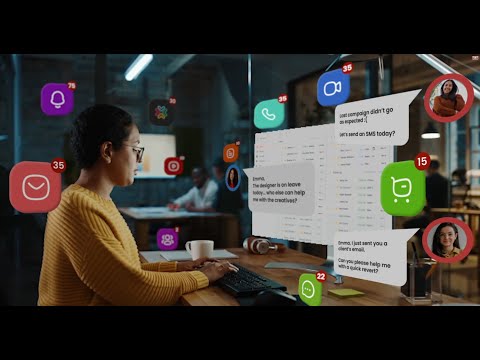Article-At-A-Glance
- Custom app demo videos can reduce SaaS sales cycles by up to 43% while increasing trial-to-paid conversions
- Today’s users make decisions about your software in just 8 seconds, making visual demonstrations crucial
- Properly structured demo videos address the “feature complexity barrier” that prevents adoption
- Companies implementing strategic demo videos see significant reductions in new user support tickets
- Demo videos serve as a 24/7 sales representative, qualifying leads even when your team is offline
In the hyper-competitive SaaS market, your brilliant product can still fail if prospects can’t quickly understand its value. The difference between growth and stagnation often comes down to how effectively you demonstrate your solution in those critical first moments of discovery. SaaSVideoLab’s research shows that companies with strategic demo videos convert at rates 3.5x higher than those relying solely on text-based explanations.
The Hidden ROI of App Demo Videos in Today’s SaaS Market
The math behind demo video ROI is compelling yet frequently overlooked. While most SaaS founders obsess over feature development and paid acquisition, they underinvest in the bridge between acquisition and activation: effective product demonstration. A single well-crafted demo video typically costs between $1,500-$5,000 to produce, yet can influence hundreds of thousands in ARR by improving conversion at multiple funnel stages.
Unlike written copy that requires cognitive effort to process, video demonstrations create immediate understanding through visual learning pathways. This neurological advantage translates directly into conversion metrics. The ROI compounds further when considering the reusability of video assets across multiple channels—from your homepage to email sequences, sales enablement, and paid campaigns.

Why SaaS Products Fail Without Proper Demonstrations
The graveyard of failed SaaS products is filled with brilliant solutions that couldn’t effectively communicate their value. Without proper demonstration, even groundbreaking features remain abstract concepts rather than tangible solutions. This communication gap creates friction at every stage of the buyer’s journey, from initial discovery to purchase decision.
The problem is particularly acute for products solving complex problems or introducing novel workflows. When prospects can’t immediately visualize how your solution integrates into their existing processes, the default response is hesitation rather than action. This hesitation manifests as abandoned trials, extended sales cycles, and missed expansion opportunities. To mitigate this, consider using custom videos for mobile apps and SaaS to clearly demonstrate your product’s value.
The 8-Second Decision Window That Makes or Breaks Conversions
Today’s digital consumers make initial judgment calls about your software in approximately 8 seconds. This micro-decision window determines whether they’ll invest additional time exploring your solution or bounce to a competitor. Text descriptions rarely capture attention within this critical timeframe, but a well-positioned demo video can immediately demonstrate value.
This attention threshold is even more pronounced in B2B environments where decision-makers are evaluating multiple solutions simultaneously. When your competition offers clear, visual demonstrations while you rely on feature lists and text explanations, you’re fighting an uphill battle for cognitive bandwidth. The 8-second window isn’t just about capturing attention—it’s about transferring enough understanding to justify further investigation.
Feature Complexity: The Silent Conversion Killer
SaaS products are becoming increasingly sophisticated, creating what I call the “feature complexity barrier.” Each new capability you develop adds value but also increases the cognitive load required to understand your product. Beyond a certain threshold, this complexity actively works against adoption.
Custom demo videos solve this paradox by transforming complex feature sets into digestible visual narratives. Rather than overwhelming prospects with comprehensive documentation, effective demos highlight specific use cases and workflows that resonate with target personas. This selective demonstration approach allows you to maintain product depth while simplifying the initial understanding process.
The most successful SaaS companies recognize that sophisticated features actually increase the need for clear demonstrations rather than diminishing it. They design their demos to create progressive discovery—showing immediate value first while revealing deeper functionality as viewer interest builds.
How Competitor Demo Videos Are Stealing Your Potential Customers
When prospects evaluate multiple solutions, they naturally gravitate toward products they can most easily understand. Your competitors’ demo videos aren’t just showcasing features—they’re creating confidence and reducing perceived implementation risk. Every day without an effective demo strategy means losing qualified prospects to competitors with clearer visual communication.
Market analysis shows that 78% of B2B software buyers watch at least three videos before making a purchase decision. If your competition appears in that rotation while you don’t, you’re at a significant disadvantage regardless of product superiority. This silent erosion of potential customer base happens without warning signals in your analytics.
5 Ways Custom Demo Videos Transform Your SaaS Growth Metrics
The impact of strategic demo videos extends far beyond surface-level engagement metrics. When properly implemented, they create measurable improvements across your entire growth framework. Let’s examine the five most significant performance indicators that change when you introduce custom demo videos to your sales and marketing ecosystem.
1. Shortened Sales Cycles by Up to 43%
Enterprise SaaS companies implementing targeted demo videos report sales cycle reductions between 27-43% depending on product complexity. This acceleration occurs primarily because videos eliminate multiple discovery calls that would otherwise be necessary to establish basic product understanding. When prospects arrive at sales conversations with foundational knowledge already established, discussions immediately advance to implementation specifics rather than general capabilities.
For products with technical complexity, this time compression delivers compound benefits—not only closing deals faster but freeing sales resources to pursue additional opportunities. The most dramatic improvements occur when demo videos address specific objections that typically emerge late in sales cycles, preemptively resolving concerns before they become sticking points.
2. Higher Trial-to-Paid Conversion Rates
The self-service conversion funnel often contains a critical drop-off point where users fail to activate key features during trial periods. Strategic demo videos placed at these activation thresholds have been shown to improve trial-to-paid conversion rates by 15-23% across B2B SaaS verticals. The improvement stems from users discovering value-driving features they might otherwise miss during limited trial exploration.
This conversion lift becomes even more pronounced for products with non-obvious benefits or delayed value realization. By visually demonstrating outcomes rather than just features, demo videos help users project future benefits, justifying purchase decisions even when immediate ROI isn’t yet apparent in their trial experience.
3. Reduced Support Tickets From New Users
New user onboarding generates significant support overhead for most SaaS operations. Companies implementing strategic demo videos report 32-40% reductions in basic functionality questions from new users. This support ticket reduction translates directly to improved margins and enables support teams to focus on higher-value customer success activities rather than repetitive explanations.
The knowledge transfer efficiency of video is particularly valuable for international customers where language barriers might otherwise necessitate multiple support interactions. Well-structured visual demonstrations frequently eliminate entire categories of support requests by creating visual reference points users can revisit independently.
4. Improved User Activation and Feature Discovery
Feature adoption correlates directly with retention rates and expansion revenue, yet most SaaS products suffer from feature blindness—users simply never discover valuable capabilities. In-app demo videos strategically placed at discovery moments increase feature activation by an average of 47% compared to text-based guides. This activation improvement directly impacts your stickiest metrics: monthly active usage and customer lifetime value.
Feature-specific micro-demos (30-60 seconds) perform particularly well when integrated into the user experience at contextually relevant moments. Rather than overwhelming users with comprehensive tutorials, progressive demonstration at the point of potential usage creates just-in-time learning that significantly improves retention of both the feature knowledge and the perceived product value. For more insights, explore how to convert viewers into customers with effective explainer videos.
5. Better Quality Leads Through Self-Qualification
Perhaps counter-intuitively, effective demo videos can simultaneously increase qualified leads while decreasing total lead volume. This happens because demonstrations create natural self-qualification—prospects who aren’t aligned with your solution self-filter after watching demonstrations, while ideal-fit customers progress further into your funnel. This qualification effect improves sales efficiency by concentrating resources on prospects with higher conversion probability.
For companies with complex products serving multiple verticals, segment-specific demo videos enhance this qualification effect by allowing prospects to self-identify with relevant use cases. The resulting improvement in lead quality frequently outweighs pure volume metrics in terms of revenue impact.

Creating Demo Videos That Actually Drive Conversions
Not all demo videos perform equally. The difference between a video that drives action and one that merely informs comes down to strategic structure, not production value. The most effective demos follow a problem-solution framework that creates immediate resonance with viewer pain points. For more insights, explore how to convert viewers into customers with explainer videos.
When analyzing conversion data across hundreds of SaaS demo videos, a clear pattern emerges: videos that begin by acknowledging specific customer challenges before demonstrating solutions consistently outperform feature-first approaches. This emotional connection creates the engagement foundation necessary for feature information to actually register.
The Problem-Solution Framework That Hooks Viewers
The highest-converting demo videos follow a three-part structure: problem identification, solution revelation, and evidence validation. Start by clearly articulating the specific pain point your target audience experiences, using language that matches their internal dialogue. This creates immediate relevance and captures attention through problem recognition.
Next, transition to solution demonstration by showing (not telling) how your product addresses this pain point. The key differentiator here is showing contextual usage rather than isolated features. Finally, reinforce the solution with evidence—quantifiable results, customer testimonials, or comparative before/after scenarios that validate your claims.
This framework works because it mirrors the natural decision-making process: recognizing a problem, evaluating potential solutions, and seeking confidence in the chosen path. When your demo video aligns with this cognitive pattern, conversion friction significantly decreases.
Critical App Features vs. “Nice-to-Haves”: What to Showcase
The temptation to showcase every feature in your demo video actually works against conversion. Analysis of high-performing videos shows they typically focus on just 3-5 core features that directly address primary user needs. This selective demonstration creates clarity rather than overwhelming viewers with comprehensive capability tours.
Prioritize features that directly solve the problem established in your opening, creating a tight narrative connection between pain point and solution. Secondary “nice-to-have” features should only appear briefly near the end or be saved for feature-specific micro-demos that supplement your main demonstration.
- Core problem-solving features deserve 60-70% of your demo runtime
- Differentiating features unique to your solution should receive 20-25%
- Supporting features and UI navigation should be limited to 10-15%
- Avoid administrative features entirely unless they represent a primary value proposition
Optimal Video Length Based on Product Complexity
Video length directly impacts completion rates, but the optimal duration varies based on product complexity and funnel position. For top-of-funnel discovery, keep demos under 90 seconds to maximize completion. For middle-funnel consideration videos, the sweet spot typically falls between 2-4 minutes, allowing deeper feature exploration while maintaining engagement.
Complex enterprise solutions can justify longer demonstrations (4-6 minutes) when targeting prospects already demonstrating serious interest. However, even these extended demos benefit from being broken into modular sections with clear navigation, allowing viewers to focus on relevant segments.
Voice-Over vs. Text-Based: Which Performs Better for SaaS
A/B testing across multiple SaaS categories shows narrated demos with professional voice-over consistently outperform text-only demonstrations by 23-31% in both completion rates and conversion actions. The audio component creates a multisensory experience that improves information retention while allowing viewers to focus visually on the interface rather than reading captions.
However, always include optional captions for accessibility and environments where audio isn’t available. The voice should match your brand personality while maintaining clarity—conversational yet authoritative tones typically perform best for SaaS demonstrations.
Technical Production Tips From Top-Performing SaaS Videos
The technical quality of your demo video directly impacts viewer perception of your product quality. While you don’t need Hollywood production values, several technical elements consistently appear in high-converting demos across the SaaS landscape.
Screen Recording Tools Worth Your Investment
Professional screen recording software makes a noticeable difference in demo quality. Tools like Camtasia, ScreenFlow, or Captivate offer capabilities that basic screen recorders lack—smooth cursor movements, zoom/pan effects to highlight important elements, and the ability to edit out errors without complete re-recording.
For teams producing regular demo content, consider investing in tools with collaboration features that allow multiple team members to contribute to production. The efficiency gains typically justify the additional cost within just a few video productions.
- Camtasia: Best all-around option for Windows/Mac with intuitive editing ($249/license)
- ScreenFlow: Mac-only with superior motion effects ($129/license)
- Loom: Excellent for quick demos with instant sharing capabilities ($8-15/month)
- Captivate: Ideal for interactive demos with decision paths ($33.99/month)
Adding Professional Polish Without a Video Team
Several production techniques create professional polish without requiring specialized video expertise. Use keyboard shortcut displays (like Keystroke or KeyCastr) to show navigational efficiency. Incorporate subtle zoom effects to highlight important interface elements during demonstration. Add consistent branded intro/outro segments (5-7 seconds each) to frame your content professionally.
Audio quality impacts perceived professionalism more than most visual elements. Invest in a decent USB microphone (Blue Yeti or Audio-Technica ATR2100x) and record in a quiet environment with minimal echo. When budget allows, professional voice talent services like Voices.com can elevate your demo for $200-500 per production.
Mobile-Friendly Formatting Requirements
With over 50% of initial product research happening on mobile devices, mobile-friendly demo formatting is non-negotiable. This requires special consideration during production. Use larger text displays than you would for desktop viewing. Highlight cursor movements with animation effects for visibility on small screens. Ensure important interface elements remain visible when compressed to mobile dimensions.
Test your completed demos on actual mobile devices rather than simulated previews to catch readability issues. For complex interfaces, consider creating separate mobile-specific versions that focus on fewer features with tighter framing rather than trying to compress your full desktop demonstration.

Strategic Placement: Where Your Demo Video Delivers Maximum Impact
The positioning of your demo video significantly impacts its conversion effect. Analysis of high-performing SaaS websites reveals specific placement patterns that maximize both viewership and resulting action.
Homepage Placement vs. Product Pages
Homepage demo videos should focus on problem-solution narrative rather than detailed feature demonstrations. Conversion data shows homepage demos perform best when positioned “above the fold” with autoplay (muted) functionality that captures immediate attention. However, the ideal placement involves a hybrid approach—a short (30-60 second) overview video on the homepage with clear pathways to more detailed demonstrations on dedicated product pages.
For multi-product companies, homepage demonstrations should focus on your flagship offering or showcase a unified platform approach rather than attempting to cover your entire product line. Direct visitors to product-specific pages for detailed demonstrations of individual solutions.
Email Nurture Sequences and Conversion Lifts
Strategic demo video placement within email nurture sequences shows dramatic impact on both engagement and conversion metrics. Placing feature-specific micro-demos at key decision points in the sequence improves click-through rates by an average of 65% compared to text-only emails.
The most effective approach incorporates progressive demonstration—starting with overview videos for early nurture stages and transitioning to specific feature demonstrations aligned with customer pain points as prospects move deeper into the sequence. This progressive approach builds product understanding while maintaining engagement throughout longer nurture cycles.
For abandoned trial recovery, targeted demo videos addressing the specific features where users typically drop off show particularly strong reactivation rates—converting up to 21% of otherwise lost opportunities when combined with limited-time incentives.
- Introduction emails: Overview demo videos (1.5-2x higher open rates)
- Mid-sequence nurture: Feature-specific micro-demos (2.7x higher click rates)
- Decision-stage emails: ROI/implementation demos (3.1x higher conversion rates)
- Reactivation sequences: Targeted feature tutorials (21% recovery on abandoned trials)
Sales Team Enablement Applications
Beyond marketing applications, custom demo videos serve as powerful sales enablement tools. High-performing sales teams leverage personalized demos in multiple formats: standard demonstrations for initial calls, objection-specific videos addressing common concerns, and custom screen recordings tailored to specific prospect requirements. This layered approach allows sales teams to efficiently address prospect needs at scale while maintaining personalization where it matters most.
Ad Campaign Performance With and Without Demo Videos
Adding demo video components to paid acquisition campaigns delivers consistent performance improvements across platforms. LinkedIn campaigns featuring demo content show 37% higher engagement rates and 28% lower cost-per-lead compared to standard image or text ads. Similarly, Google display campaigns that incorporate video demonstrations improve quality scores and click-through rates while reducing overall acquisition costs by creating pre-qualified click behavior.
Social Proof Integration Techniques
Combining demo videos with social proof elements creates a particularly powerful conversion effect. When demonstration content includes subtle social validation—such as customer logos, usage statistics, or brief testimonial overlays—conversion rates improve by an additional 17-24% compared to standalone demonstrations. This integration addresses both the “how it works” and “who else trusts it” questions simultaneously, removing multiple conversion barriers in a single content asset.
From Demo Video to Growth Engine: Next Steps
Transforming your demo video strategy from a one-time project into an ongoing growth engine requires systematic implementation. Start by auditing your current customer journey to identify critical decision points where visual demonstration would address specific friction. Prioritize these opportunities based on potential conversion impact, beginning with your highest-traffic touchpoints. Develop a consistent production framework that allows for efficient creation of both overview and feature-specific demonstrations. Finally, implement proper analytics to measure not just view counts but actual conversion impact—connecting video engagement metrics to your broader growth framework.

Frequently Asked Questions
Q: How long should my SaaS demo video be to maximize engagement?
Q: What’s the average cost to produce a professional-quality app demo video?
Q: Should we create different demo videos for different user personas?
Q: How often should we update our demo videos when features change?
Q: Can demo videos replace live product demos in the sales process?
Remember that your demo video strategy should evolve alongside your product. Regularly reviewing performance metrics and gathering viewer feedback helps refine your approach over time, continuously improving the conversion impact of your demonstration assets.





